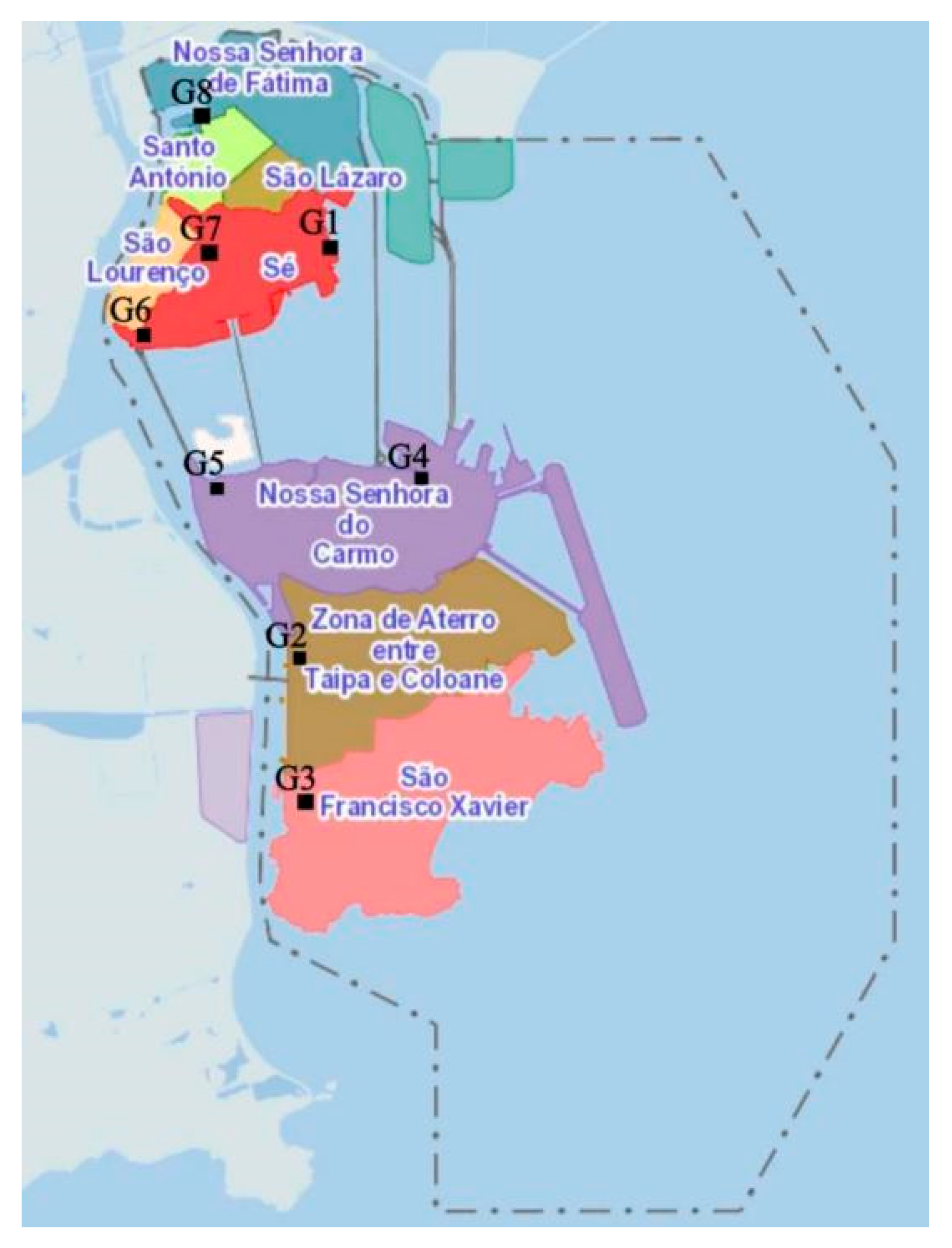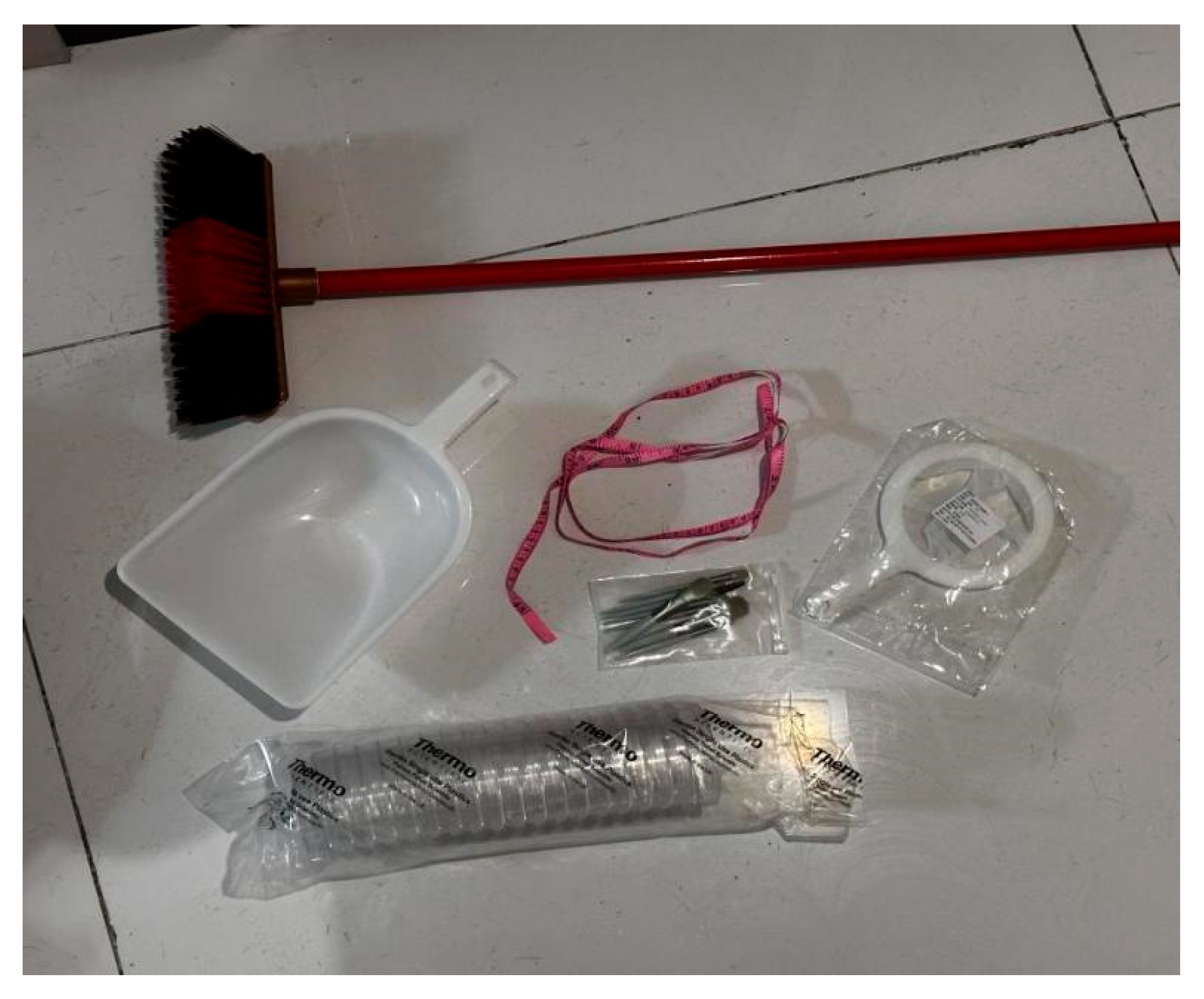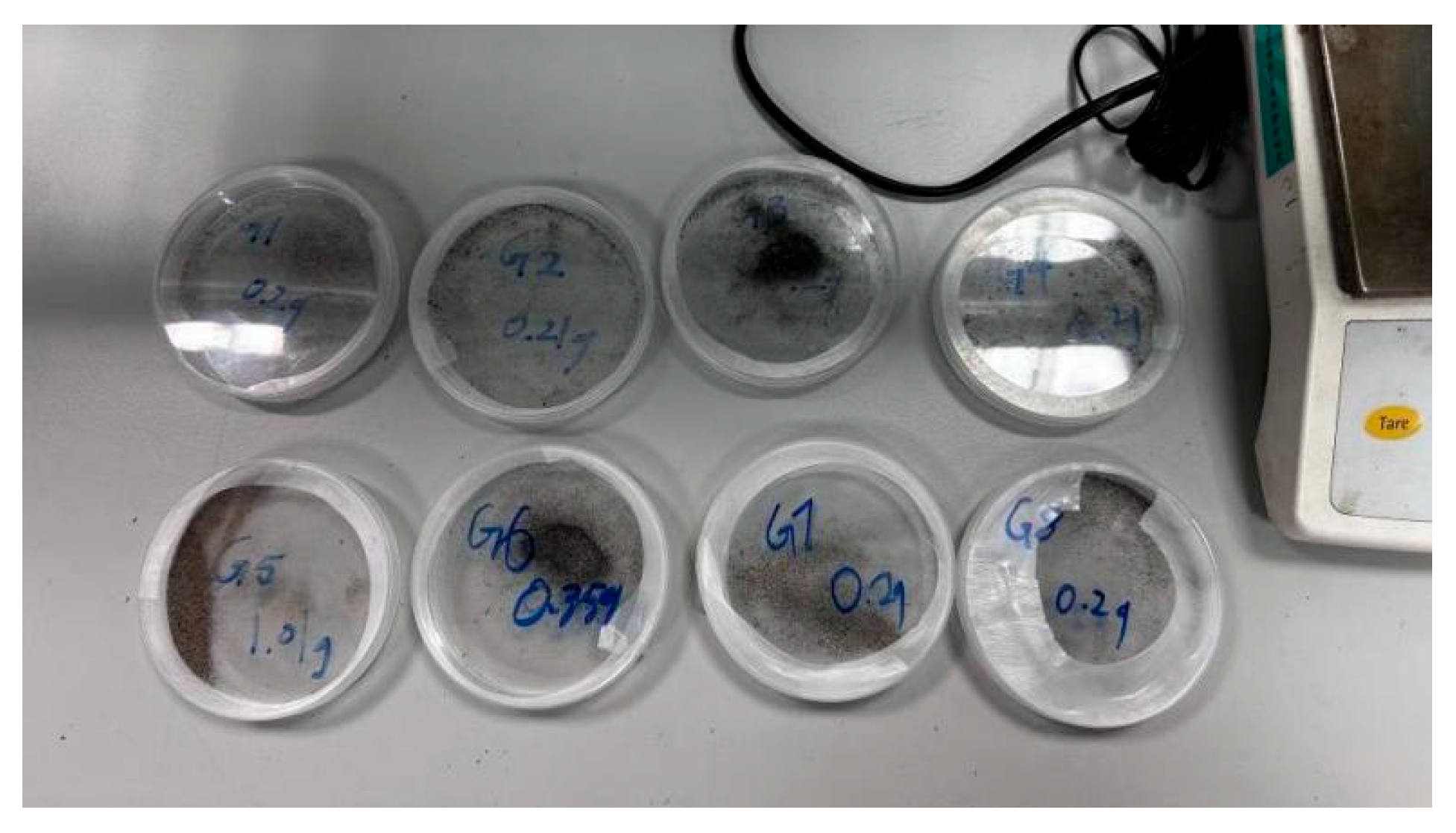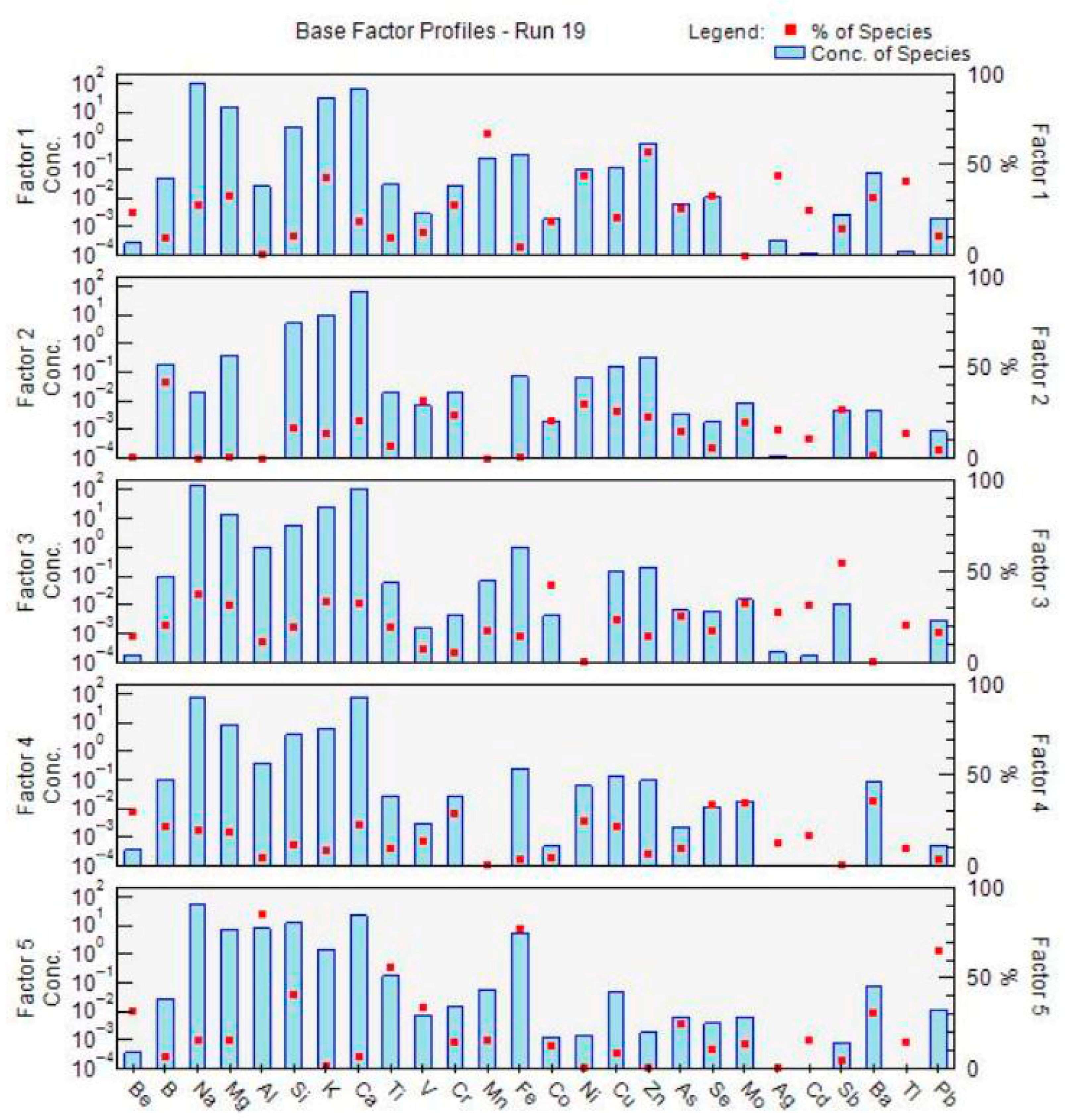Preliminary Findings of Heavy Metal Contents from Road Dust and Health Risk Assessments Towards a More Sustainable Future in Macao
Abstract
1. Introduction
2. Materials and Methods
2.1. Road Dust Sampling Locations
2.2. Collection Procedure
2.3. Analysis Procedure
2.4. Positive Matrix Factorization (PMF 5.0) Model
2.5. Non-Carcinogenic Health Risk Assessment
2.6. Carcinogenic Risk Assessment
3. Results and Discussion
3.1. Characteristics of Sampling Sites
3.2. Heavy Metal Concentrations in Road Dust
3.3. Result of PMF 5.0 Model
3.4. Result of Health Risk Assessment
3.5. Discussion
4. Conclusions
Author Contributions
Funding
Institutional Review Board Statement
Informed Consent Statement
Data Availability Statement
Acknowledgments
Conflicts of Interest
References
- Hao, Q.; Lu, X.; Yu, B.; Yang, Y.; Lei, K.; Pan, H.; Gao, Y.; Liu, P.; Wang, Z. Sources and Probabilistic Ecological-Health Risks of Heavy Metals in Road Dust from Urban Areas in a Typical Industrial City. Urban Clim. 2023, 52, 101730. [Google Scholar] [CrossRef]
- Lahiri, D.; Ray, I.; Ray, R.; Chanakya, I.V.S.; Tarique, M.; Misra, S.; Rahaman, W.; Tiwari, M.; Wang, X.; Das, R. Source Apportionment and Emission Projections of Heavy Metals from Traffic Sources in India: Insights from Elemental and Pb Isotopic Compositions. J. Hazard. Mater. 2024, 480, 135810. [Google Scholar] [CrossRef]
- Heidari, M.; Darijani, T.; Alipour, V. Heavy Metal Pollution of Road Dust in a City and Its Highly Polluted Suburb; Quantitative Source Apportionment and Source-Specific Ecological and Health Risk Assessment. Chemosphere 2021, 273, 129656. [Google Scholar] [CrossRef]
- Achakulwisut, P.; Anenberg, S.C.; Neumann, J.E.; Penn, S.L.; Weiss, N.; Crimmins, A.; Fann, N.; Martinich, J.; Roman, H.; Mickley, L.J. Effects of Increasing Aridity on Ambient Dust and Public Health in the U.S. Southwest Under Climate Change. Geohealth 2019, 3, 127–144. [Google Scholar] [CrossRef]
- Casotti Rienda, I.; Alves, C.A. Road Dust Resuspension: A Review. Atmos. Res. 2021, 261, 105740. [Google Scholar] [CrossRef]
- Du, X.; Zhu, Y.; Han, Q.; Yu, Z. The Influence of Traffic Density on Heavy Metals Distribution in Urban Road Runoff in Beijing, China. Environ. Sci. Pollut. Res. 2019, 26, 886–895. [Google Scholar] [CrossRef] [PubMed]
- Duong, T.T.T.; Lee, B.-K. Determining Contamination Level of Heavy Metals in Road Dust from Busy Traffic Areas with Different Characteristics. J. Environ. Manag. 2011, 92, 554–562. [Google Scholar] [CrossRef] [PubMed]
- El-Sharkawy, M.; Alotaibi, M.O.; Li, J.; Du, D.; Mahmoud, E. Heavy Metal Pollution in Coastal Environments: Ecological Implications and Management Strategies: A Review. Sustainability 2025, 17, 701. [Google Scholar] [CrossRef]
- Farahani, V.J.; Soleimanian, E.; Pirhadi, M.; Sioutas, C. Long-Term Trends in Concentrations and Sources of PM2.5–Bound Metals and Elements in Central Los Angeles. Atmos. Environ. 2021, 253, 118361. [Google Scholar] [CrossRef]
- Gietl, J.K.; Lawrence, R.; Thorpe, A.J.; Harrison, R.M. Identification of Brake Wear Particles and Derivation of a Quantitative Tracer for Brake Dust at a Major Road. Atmos. Environ. 2010, 44, 141–146. [Google Scholar] [CrossRef]
- He, C.-T.; Zheng, X.-B.; Yan, X.; Zheng, J.; Wang, M.-H.; Tan, X.; Qiao, L.; Chen, S.-J.; Yang, Z.-Y.; Mai, B.-X. Organic Contaminants and Heavy Metals in Indoor Dust from E-Waste Recycling, Rural, and Urban Areas in South China: Spatial Characteristics and Implications for Human Exposure. Ecotoxicology 2017, 140, 109–115. [Google Scholar] [CrossRef]
- Hong, N.; Guan, Y.; Yang, B.; Zhong, J.; Zhu, P.; Ok, Y.S.; Hou, D.; Tsang, D.C.W.; Guan, Y.; Liu, A. Quantitative Source Tracking of Heavy Metals Contained in Urban Road Deposited Sediments. J. Hazard. Mater. 2020, 393, 122362. [Google Scholar] [CrossRef]
- Hong, N.; Yang, B.; Tsang, D.C.W.; Liu, A. Comparison of Pollutant Source Tracking Approaches: Heavy Metals Deposited on Urban Road Surfaces as a Case Study. Environ. Pollut. 2020, 266, 115253. [Google Scholar] [CrossRef] [PubMed]
- Huang, C.; Zhang, L.; Meng, J.; Yu, Y.; Qi, J.; Shen, P.; Li, X.; Ding, P.; Chen, M.; Hu, G. Characteristics, Source Apportionment and Health Risk Assessment of Heavy Metals in Urban Road Dust of the Pearl River Delta, South China. Ecotoxicology 2022, 236, 113490. [Google Scholar] [CrossRef]
- Roganović, J.; Relić, D.; Zarić, M.; Aničić Urošević, M.; Zinicovscaia, I.; Ilijević, K.; Zarić, N.M. Rare Earth Elements and Health Risk Assessment of Road Dust from the Vicinity of Coal Fired Thermal Power Plants. Chemosphere 2025, 377, 144329. [Google Scholar] [CrossRef] [PubMed]
- Men, C.; Liu, R.; Xu, L.; Wang, Q.; Guo, L.; Miao, Y.; Shen, Z. Source-Specific Ecological Risk Analysis and Critical Source Identification of Heavy Metals in Road Dust in Beijing, China. J. Hazard. Mater. 2020, 388, 121763. [Google Scholar] [CrossRef] [PubMed]
- Khademi, H.; Gabarrón, M.; Abbaspour, A.; Martínez-Martínez, S.; Faz, A.; Acosta, J.A. Environmental Impact Assessment of Industrial Activities on Heavy Metals Distribution in Street Dust and Soil. Chemosphere 2019, 217, 695–705. [Google Scholar] [CrossRef]
- Li, P.; Lin, C.; Cheng, H.; Duan, X.; Lei, K. Contamination and Health Risks of Soil Heavy Metals around a Lead/Zinc Smelter in Southwestern China. Ecotoxicology 2015, 113, 391–399. [Google Scholar] [CrossRef]
- Luo, S.; Chen, R.; Han, J.; Zhang, W.; Petropoulos, E.; Liu, Y.; Feng, Y. Urban Green Space Area Mitigates the Accumulation of Heavy Metals in Urban Soils. Chemosphere 2024, 352, 141266. [Google Scholar] [CrossRef]
- Mahmoud, N.; Al-Shahwani, D.; Al-Thani, H.; Isaifan, R.J. Risk Assessment of the Impact of Heavy Metals in Urban Traffic Dust on Human Health. Atmosphere 2023, 14, 1049. [Google Scholar] [CrossRef]
- Rahman, M.S.; Sarker, M.A.M.; Hasan, M.; Akhter, S.; Jolly, Y.N.; Choudhury, T.R.; Hussain, K.M.A.; Rahman, S.M.M.; Islam, R.; Begum, B.A. Incorporating Source Apportionment and Health Risk Assessment of Heavy Metals from Indoor Dust of an Industrial Area in Dhaka, Bangladesh. Environ. Surf. Interfaces 2024, 2, 26–40. [Google Scholar] [CrossRef]
- Nagajyoti, P.C.; Lee, K.D.; Sreekanth, T.V.M. Heavy Metals, Occurrence and Toxicity for Plants: A Review. Environ. Chem. Lett. 2010, 8, 199–216. [Google Scholar] [CrossRef]
- U.S. Environmental Protection Agency. Soil Screening Guidance: Technical Background Document; U.S. Environmental Protection Agency: Washington, DC, USA, 1996.
- Suvetha, M.; Charles, P.E.; Vinothkannan, A.; Rajaram, R.; Paray, B.A.; Ali, S. Are we at risk because of road dust? An ecological and health risk assessment of heavy metals in a rapidly growing city in South India. Environ. Adv. 2022, 7, 100165. [Google Scholar] [CrossRef]
- Okechukwu Ohiagu, F.; Chikezie, P.C.; Ahaneku, C.C.; Chikezie, C.M. Human Exposure to Heavy Metals: Toxicity Mechanisms and Health Implications. Mater. Sci. Eng. Int. J. 2022, 6, 78–87. [Google Scholar] [CrossRef]
- Pan, H.; Lu, X.; Lei, K. A Comprehensive Analysis of Heavy Metals in Urban Road Dust of Xi’an, China: Contamination, Source Apportionment and Spatial Distribution. Sci. Total Environ. 2017, 609, 1361–1369. [Google Scholar] [CrossRef] [PubMed]
- Qadeer, A.; Saqib, Z.A.; Ajmal, Z.; Xing, C.; Khan Khalil, S.; Usman, M.; Huang, Y.; Bashir, S.; Ahmad, Z.; Ahmed, S.; et al. Concentrations, Pollution Indices and Health Risk Assessment of Heavy Metals in Road Dust from Two Urbanized Cities of Pakistan: Comparing Two Sampling Methods for Heavy Metals Concentration. Sustain. Cities Soc. 2020, 53, 101959. [Google Scholar] [CrossRef]
- Qi, M.; Wu, Y.; Zhang, S.; Li, G.; An, T. Pollution Profiles, Source Identification and Health Risk Assessment of Heavy Metals in Soil near a Non-Ferrous Metal Smelting Plant. Int. J. Environ. Res. Public Health 2023, 20, 1004. [Google Scholar] [CrossRef] [PubMed]
- Rabha, S.; Dhaneesh, K.V. The Impact of Heavy Metal Accumulation on Agricultural Soils and Its Mitigation. Uttar Pradesh J. Zool. 2024, 45, 77–89. [Google Scholar] [CrossRef]
- Rahman, Z.; Singh, V.P. The Relative Impact of Toxic Heavy Metals (THMs) (Arsenic (As), Cadmium (Cd), Chromium (Cr)(VI), Mercury (Hg), and Lead (Pb)) on the Total Environment: An Overview. Environ. Monit. Assess. 2019, 191, 419. [Google Scholar] [CrossRef]
- Song, H.; Li, J.; Li, L.; Dong, J.; Hou, W.; Yang, R.; Zhang, S.; Zu, S.; Ma, P.; Zhao, W. Heavy Metal Pollution Characteristics and Source Analysis in the Dust Fall on Buildings of Different Heights. Int. J. Environ. Res. Public Health 2022, 19, 11376. [Google Scholar] [CrossRef]
- Yang, J.; Zhao, Y.; Ruan, X.; Zhang, G. Anthropogenic Contribution and Migration of Soil Heavy Metals in the Vicinity of Typical Highways. Agronomy 2023, 13, 303. [Google Scholar] [CrossRef]
- Zhao, L.; Hu, G.; Yan, Y.; Yu, R.; Cui, J.; Wang, X.; Yan, Y. Source Apportionment of Heavy Metals in Urban Road Dust in a Continental City of Eastern China: Using Pb and Sr Isotopes Combined with Multivariate Statistical Analysis. Atmos. Environ. 2019, 201, 201–211. [Google Scholar] [CrossRef]
- Lei, T.M.T.; Cai, J.; Cheng, W.-H.; Kurniawan, T.A.; Molla, A.H.; Mohd Nadzir, M.S.; Kong, S.S.-K.; Chen, L.-W.A. Application of Deep Learning Techniques for Air Quality Prediction: A Case Study in Macau. Processes 2025, 13, 1507. [Google Scholar] [CrossRef]
- Khan, M.M.H.; Kurniawan, T.A.; Chandra, I.; Lei, T.M.T. Modeling PM10 Emissions in Quarry and Mining Operations: Insights from AERMOD Applications in Malaysia. Atmosphere 2025, 16, 369. [Google Scholar] [CrossRef]
- Biswas, P.; Rashid, A.; Habib, A.K.M.A.; Mahmud, M.; Motakabber, S.M.A.; Hossain, S.; Rokonuzzaman, M.; Molla, A.H.; Harun, Z.; Khan, M.M.H.; et al. Vehicle to Grid: Technology, Charging Station, Power Transmission, Communication Standards, Techno-Economic Analysis, Challenges, and Recommendations. World Electr. Veh. J. 2025, 16, 142. [Google Scholar] [CrossRef]
- Brown, R.J.C.; Van Aswegen, S.; Webb, W.R.; Goddard, S.L. UK Concentrations of Chromium and Chromium (VI), Measured as Water Soluble Chromium, in PM10. Atmos. Environ. 2014, 99, 385–391. [Google Scholar] [CrossRef]
- Jun, M.-J.; Gu, Y. Effects of Transboundary PM2.5 Transported from China on the Regional PM2.5 Concentrations in South Korea: A Spatial Panel-Data Analysis. PLoS ONE 2023, 18, e0281988. [Google Scholar] [CrossRef]
- Hulskotte, J.H.J.; Roskam, G.D.; Denier van der Gon, H.A.C. Elemental Composition of Current Automotive Braking Materials and Derived Air Emission Factors. Atmos. Environ. 2014, 99, 436–445. [Google Scholar] [CrossRef]
- Wang, J.M.; Jeong, C.-H.; Hilker, N.; Healy, R.M.; Sofowote, U.; Debosz, J.; Su, Y.; Munoz, A.; Evans, G.J. Quantifying Metal Emissions from Vehicular Traffic Using Real World Emission Factors. Environ. Pollut. 2021, 268, 115805. [Google Scholar] [CrossRef] [PubMed]
- Cundy, A.B.; Rowlands, F.M.; Lu, G.; Wang, W.-X. A Systematic Review of Emerging Contaminants in the Greater Bay Area (GBA), China: Current Baselines, Knowledge Gaps, and Research and Management Priorities. Environ. Sci. Policy 2022, 131, 196–208. [Google Scholar] [CrossRef]
- Zhou, Y.; Wei, T.; Chen, S.; Wang, S.; Qiu, R. Pathways to a More Efficient and Cleaner Energy System in Guangdong-Hong Kong-Macao Greater Bay Area: A System-Based Simulation During 2015–2035. Resour. Conserv. Recycl. 2021, 174, 105835. [Google Scholar] [CrossRef]
- Song, Q.; Sun, C.; Wang, Z.; Cai, K. Municipal Solid Waste to Electricity Development and Future Trend in China: A Special Life Cycle Assessment Case Study of Macau. In Waste-to-Energy; Ren, J., Ed.; Academic Press: Cambridge, MA, USA, 2020; pp. 177–212. [Google Scholar] [CrossRef]
- Huang, Z. Discussion on Road Traffic Problems and “Public Transport Priority” Policy in the Macau Peninsula. World J. Eng. Technol. 2020, 8, 631–641. [Google Scholar] [CrossRef]
- Kim, S.K.; Wang, J. A Dataset on Public Bus Transportation during Normal and Grand Prix Seasons in the Macao Area. Sci. Data 2025, 12, 1306. [Google Scholar] [CrossRef]
- Du, H.; Lu, X.; Han, X. Determination of Priority Control Factors for Risk Management of Heavy Metal(Loid)s in Park Dust in Mianyang City. Sci. Rep. 2024, 14, 27440. [Google Scholar] [CrossRef]
- Zhou, F.; Guo, H.; Liu, L. Quantitative Identification and Source Apportionment of Anthropogenic Heavy Metals in Marine Sediment of Hong Kong. Environ. Geol. 2007, 53, 295–305. [Google Scholar] [CrossRef]
- Zhou, F.; Guo, H.; Hao, Z. Spatial Distribution of Heavy Metals in Hong Kong’s Marine Sediments and Their Human Impacts: A GIS-Based Chemometric Approach. Mar. Pollut. Bull. 2007, 54, 1372–1384. [Google Scholar] [CrossRef] [PubMed]
- Li, X.; Poon, C.-S.; Liu, P.S. Heavy Metal Contamination of Urban Soils and Street Dusts in Hong Kong. Appl. Geochem. 2001, 16, 1361–1368. [Google Scholar] [CrossRef]
- EPA/600/R-14/108; EPA Positive Matrix Factorization (PMF) 5.0 Fundamentals and User Guide. U.S. Environmental Protection Agency: Washington, DC, USA, 2014.
- U.S. Environmental Protection Agency (EPA). Human Exposure Model (HEM); U.S. Environmental Protection Agency: Washington, DC, USA, 2023. Available online: https://www.epa.gov/fera/risk-assessment-and-modeling-human-exposure-model-hem (accessed on 1 September 2025).
- Kim, E.; Hopke, P.K.; Edgerton, E.S. Improving Source Identification of Atlanta Aerosol Using Temperature Resolved Carbon Fractions in Positive Matrix Factorization. Atmos. Environ. 2004, 38, 3349–3362. [Google Scholar] [CrossRef]
- Hopke, P.K.; Dai, Q.; Li, L.; Feng, Y. Global Review of Recent Source Apportionments for Airborne Particulate Matter. Sci. Total Environ. 2020, 740, 140091. [Google Scholar] [CrossRef]
- Men, C.; Liu, R.; Wang, Q.; Miao, Y.; Wang, Y.; Jiao, L.; Li, L.; Cao, L.; Shen, Z.; Li, Y.; et al. Spatial-Temporal Characteristics, Source-Specific Variation and Uncertainty Analysis of Health Risks Associated with Heavy Metals in Road Dust in Beijing, China. Environ. Pollut. 2021, 278, 116866. [Google Scholar] [CrossRef]





| Sampling Weight (g) | Motorcycle | Private Car | Taxi | Bus | Truck | Total Number of Vehicles | Pavement Material | Temperature (°C) | Relative Humidity (%) | |
|---|---|---|---|---|---|---|---|---|---|---|
| G1 | 0.2 | 56 | 121 | 38 | 46 | 17 | 278 | Pitch | 28.5 | 45 |
| G2 | 0.21 | 0 | 16 | 36 | 17 | 0 | 69 | Pitch | 29.5 | 73 |
| G3 | 0.2 | 18 | 48 | 8 | 8 | 1 | 83 | Pitch | 30.5 | 68 |
| G4 | 0.2 | 10 | 46 | 0 | 4 | 37 | 97 | Pitch | 28.5 | 78 |
| G5 | 0.21 | 53 | 306 | 47 | 36 | 18 | 460 | Cement | 28.5 | 80 |
| G6 | 0.37 | 102 | 74 | 8 | 34 | 12 | 230 | Cement | 28.5 | 75 |
| G7 | 0.2 | 10 | 11 | 1 | 1 | 1 | 24 | Gravel | 27.5 | 78 |
| G8 | 0.2 | 8 | 37 | 24 | 0 | 0 | 69 | Pitch | 27.5 | 78 |
| 9 | Na | Mg | Al | Si | K | Ca | Ni | As | Cu | Pb | V | Zn | Mn | Fe | Cr | Be | B |
|---|---|---|---|---|---|---|---|---|---|---|---|---|---|---|---|---|---|
| G1 | 114.56 | 15.49 | 2.8 | 32.32 | 42.67 | 341.47 | 0.303 | 0.02 | 0.64 | 0.007 | 0.029 | 1.2 | 0.059 | 1.96 | 0.113 | 6.27 × 10−4 | 0.754 |
| G2 | 313.8 | 33.19 | 1.16 | 13.24 | 54.072 | 333.43 | 0.256 | 0.01 | 0.53 | 0.005 | 0.015 | 1.67 | 0.195 | 1.53 | 0.076 | 9.04 × 10−4 | 0.379 |
| G3 | 522.05 | 68.66 | 1.16 | 26.23 | 167.2 | 508.15 | 0.316 | 0.03 | 0.65 | 0.009 | 0.015 | 2.76 | 0.906 | 2.28 | 0.089 | 9.54 × 10−4 | 0.424 |
| G4 | 462.3 | 45.42 | 2.65 | 31.62 | 95.46 | 528.45 | 0.256 | 0.03 | 1.01 | 0.011 | 0.027 | 1.39 | 0.127 | 3.06 | 0.099 | 8.25 × 10−4 | 0.903 |
| G5 | 617.53 | 75.27 | 55.22 | 99.83 | 58.16 | 291.27 | 0.088 | 0.05 | 0.54 | 0.077 | 0.057 | 0.94 | 0.723 | 38.23 | 0.116 | 2.91 × 10−3 | 0.265 |
| G6 | 235.02 | 29.62 | 0.96 | 12.53 | 34.38 | 237.59 | 0.124 | 0.01 | 0.35 | 0.003 | 0.006 | 0.66 | 0.13 | 0.87 | 0.057 | 7.37 × 10−4 | 0.293 |
| G7 | 314.52 | 32.95 | 1.68 | 12.27 | 62.28 | 226.74 | 0.17 | 0.02 | 0.39 | 0.005 | 0.009 | 0.71 | 0.255 | 1.7 | 0.06 | 8.77 × 10−4 | 0.214 |
| G8 | 491.1 | 58.98 | 8.11 | 27.31 | 95.27 | 351.95 | 0.417 | 0.03 | 0.85 | 0.067 | 0.022 | 4.04 | 0.747 | 7.71 | 0.131 | 1.50 × 10−3 | 0.551 |
| Compound | Din | Dih | Dd | HQin | HQih | HQd | HI |
|---|---|---|---|---|---|---|---|
| Be | 8.23 × 10−10 | 1.21 × 10−13 | 3.28 × 10−12 | ||||
| Cr | 6.55 × 10−8 | 9.64 × 10−12 | 2.61 × 10−10 | 2.18 × 10−5 | 3.32 × 10−7 | 4.36 × 10−6 | 2.65 × 10−5 |
| Ni | 1.70 × 10−7 | 2.50 × 10−11 | 6.77 × 10−10 | ||||
| Cu | 4.36 × 10−7 | 6.41 × 10−11 | 1.74 × 10−9 | 1.09 × 10−5 | 1.60 × 10−9 | 1.45 × 10−7 | 1.10 × 10−5 |
| Zn | 1.17 × 10−6 | 1.73 × 10−10 | 4.69 × 10−9 | 3.92 × 10−8 | 7.82 × 10−8 | 1.17 × 10−7 | |
| As | 1.83 × 10−8 | 2.69 × 10−12 | 7.31 × 10−11 | ||||
| Cd | 4.31 × 10−10 | 6.34 × 10−14 | 1.72 × 10−12 | 4.31 × 10−7 | 1.72 × 10−7 | 6.04 × 10−7 | |
| Pb | 1.61 × 10−8 | 2.36 × 10−12 | 6.41 × 10−11 | 4.59 × 10−6 | 7.88 × 10−12 | 1.21 × 10−7 | 4.71 × 10−6 |
| Compound | LADD | Carcinogenic Risk (CR) | Total CR |
|---|---|---|---|
| Be | 5.99 × 10−14 | ||
| Cr | 4.75 × 10−12 | 2.00 × 10−10 | |
| Ni | 1.24 × 10−11 | ||
| Cu | 3.17 × 10−11 | ||
| Zn | 8.56 × 10−11 | ||
| As | 1.32 × 10−12 | ||
| Cd | 3.14 × 10−14 | 1.98 × 10−13 | |
| Pb | 1.17 × 10−12 | 4.91 × 10−10 | |
| Total CR | 6.91 × 10−10 |
| Heavy Metals | Total Vehicle Counts |
|---|---|
| Na | 0.11 |
| Mg | 0.19 |
| Al | 0.79 |
| Si | 0.82 |
| K | −0.41 |
| Ca | −0.27 |
| Ni | −0.54 |
| As | 0.50 |
| Cu | −0.21 |
| Pb | 0.47 |
| V | 0.77 |
| Zn | −0.41 |
| Mn | 0.07 |
| Fe | 0.77 |
| Cr | 0.33 |
Disclaimer/Publisher’s Note: The statements, opinions and data contained in all publications are solely those of the individual author(s) and contributor(s) and not of MDPI and/or the editor(s). MDPI and/or the editor(s) disclaim responsibility for any injury to people or property resulting from any ideas, methods, instructions or products referred to in the content. |
© 2025 by the authors. Licensee MDPI, Basel, Switzerland. This article is an open access article distributed under the terms and conditions of the Creative Commons Attribution (CC BY) license (https://creativecommons.org/licenses/by/4.0/).
Share and Cite
Lei, T.M.T.; Liu, Y.; Ye, W.; Cheng, W.H.; Molla, A.H.; Chen, L.-W.A.; Wu, S. Preliminary Findings of Heavy Metal Contents from Road Dust and Health Risk Assessments Towards a More Sustainable Future in Macao. Sustainability 2025, 17, 10433. https://doi.org/10.3390/su172310433
Lei TMT, Liu Y, Ye W, Cheng WH, Molla AH, Chen L-WA, Wu S. Preliminary Findings of Heavy Metal Contents from Road Dust and Health Risk Assessments Towards a More Sustainable Future in Macao. Sustainability. 2025; 17(23):10433. https://doi.org/10.3390/su172310433
Chicago/Turabian StyleLei, Thomas M. T., Yuyang Liu, Wenlong Ye, Wan Hee Cheng, Altaf Hossain Molla, L.-W. Antony Chen, and Shuiping Wu. 2025. "Preliminary Findings of Heavy Metal Contents from Road Dust and Health Risk Assessments Towards a More Sustainable Future in Macao" Sustainability 17, no. 23: 10433. https://doi.org/10.3390/su172310433
APA StyleLei, T. M. T., Liu, Y., Ye, W., Cheng, W. H., Molla, A. H., Chen, L.-W. A., & Wu, S. (2025). Preliminary Findings of Heavy Metal Contents from Road Dust and Health Risk Assessments Towards a More Sustainable Future in Macao. Sustainability, 17(23), 10433. https://doi.org/10.3390/su172310433









